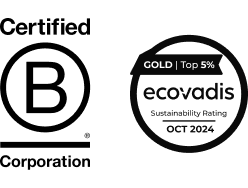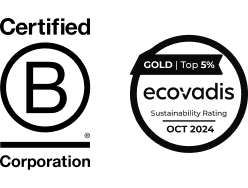There’s no denying workplace collaboration drives innovation and has shaped the evolution of office spaces. Still, the need for privacy to maintain productivity and wellbeing is challenging in modern setups.
To keep staff happy and productive in the long run, the workplaces of tomorrow must re-establish a balance between community and privacy, mitigating the impact of workplace distractions on individuals while still keeping collaboration intact. Let’s explore how to achieve this balance.
Unpacking the importance of workplace privacy
On average, office workers face an interruption every three minutes. And it takes about 23 minutes to fully regain focus on a task after being distracted, according to research from the University of California.
In open-plan office environments, feeling overexposed to this constant barrage of distractions (and the time it takes to recover) significantly impacts employee productivity and engagement, as well as individual cognitive, emotional, and even physical wellbeing.
While there's no denying that open, face-to-face collaboration can benefit innovation and problem-solving for organisations, the effects of workplace distractions highlight the need for better employee privacy in the workplace.
Although the open-plan office has become the norm, hybrid and remote practices have caused another shift in our approach to work. Extended periods of uninterrupted focus time have reminded us that while collaboration is key to going further, privacy is the fuel that keeps us going for longer.
As more businesses struggle to strike the right balance between providing private individual work spaces without compromising shared, collaborative spaces, the question of what an effective workplace design looks like comes increasingly into focus—especially in a hybrid world where employees have experienced the privacy benefits that come with working remotely.
Privacy as an extension of control
Research into workplace privacy conducted by Steelcase shows that while most people think about privacy in terms of others bothering us, it’s really more a matter of control. Over their decades-long study, Steelcase researchers identified four mechanisms for regulating privacy in a physical space, being:
1. Acoustic privacy: Being free from noise distractions or able to create noise without distracting others.
2. Visual privacy: Not being seen by others or freedom from sight-induced distractions.
3. Territorial privacy: Claiming a space and controlling it as your own.
4. Informational privacy: Keeping analogue or digital information or conversations confidential.
These four mechanisms can be categorised into two spheres of individual privacy: information–or what others can know about us–and stimulation–or sensory-based distractions. In the modern workplace, workers exercise privacy by habitually and repeatedly shifting between revealing and concealing themselves, as well as seeking out and blocking out stimuli.
A balance of both private solitude and collective participation, and the ability to freely oscillate between the two states, are the mark of an effective workplace environment.
By understanding privacy as a means of controlling what others can see, hear, and know about each other, companies can create environments that better support their employees' needs. This approach mitigates distractions and helps create a more attractive and conducive office environment that employees actually want to be in.
Understanding how employees experience privacy
Apart from providing the space for employees to regulate individual privacy, the Steelcase research also revealed a set of principles that can help companies better understand their employees' privacy needs.
These principles speak to how people experience privacy, the psychological impact of these private experiences, and what they mean for individual productivity.
1. Strategic anonymity, or being “invisible”
Anonymity is crucial for privacy as it liberates us from typical workplace monitoring, allowing us to work without being recognised or interrupted. We strategically seek anonymity by, for example, working in a café or using avatars in online forums.
2. Selective exposure, or choosing what other see
How we shape our identities and present ourselves changes depending on the context; who we are with loved ones can vastly differ from who we are at work. Influences like culture, gender, and personality also affect how comfortable we are disclosing personal information in a workplace setting.
3. Entrusted confidence, or confidential information sharing
Privacy is not just about individual solitude; it also involves having confidential conversations with a trusted few in the workplace. In open-plan offices, the lack of private spaces can hinder spontaneous discussions, affecting opportunities for feedback and rapport building.
4. Intentional shielding, or self-protection
Though we might not realise it, the negative feelings associated with personal space invasion often occur in the workplace, leading us to protect ourselves from distractions and prying eyes by, for example, wearing headphones or hiding our screens. We might also intentionally shield ourselves to maintain independence and develop unique insights for when collaboration does happen.
5. Purposeful solitude, or separating oneself
Intentionally seeking solitude in the workplace is essential for deep work, recharging, or personal activities, even in collectivist cultures like China, for example. Taking a break outside, sitting in a secluded spot, or finding a private room are all instances of purposeful solitude.
Integrating privacy and collaboration
“What's been overlooked in the push for collaborative work is the value of individual time," points out Donna Flynn, a Director at Steelcase. Although collaborative work does produce high-quality solutions, endlessly collaborating, day in and day out, is a recipe for burnout.
According to one source, 32% of employees believe open-plan office designs reduce productivity due to distractions, while 56% believe a quiet, private environment increases productivity.
Open-plan offices encourage interaction and teamwork but often leave much to be desired when it comes to privacy for focused work. Achieving the right balance between privacy and collaboration is fundamentally about empowering people with choices and some measure of control over their environment.
"The way to support people is to provide the ability to move between individual time and collaborative time, having that rhythm between coming together to think about a problem and then going away to let those ideas gestate," says Flynn.
Flexible workplace design is key to integrating privacy and collaboration in a way that supports both individual and group efforts.
3 practical solutions for workplace privacy
The future of workplace design lies in creating an ecosystem of interrelated zones catering to privacy and collaboration. Thoughtfully designing spaces and integrating technology intelligently can help companies achieve this balance.
1. Enclosed private spaces
Secluded office pods, semi-permanent booths, and private rooms offer employees dedicated areas for deep work without the distraction of ambient office noise, providing a quiet sanctuary within a bustling environment. Private enclosed pod spaces like these are also helpful for confidential activities like performance reviews or sensitive discussions, while designated quiet zones ensure that employees can access whole areas where uninterrupted work is prioritised.

2. Flexible and reconfigurable furniture
Movable furniture, mobile desks and chairs, and modular layouts allow employees to quickly and easily reconfigure their spaces to meet their varying privacy needs throughout the day. Adjustable screens and dividers also offer quick and effective solutions for personal space management, letting people establish boundaries as required. This adaptability creates a workspace that remains dynamic and responsive to the changing demands of different tasks and preferences.

3. Acoustic and visual barriers
Acoustic panels, sound-absorbing materials, visual barriers, and biophilic elements like plants and natural features can create sensory privacy without isolating employees completely. Incorporating advanced technology, such as optimised lighting for video calls and noise-cancelling headphones, further enhances the functionality of both private and collaborative workspaces, helping to maintain a seamless flow between solitude and interaction.

Summary
Balancing privacy and collaboration in the workplace is essential for creating a productive and engaging environment. Giving employees control over their workspaces through a combination of private and shared spaces helps minimise distractions while supporting their diverse privacy needs.
By carefully integrating enclosed private spaces, flexible and reconfigurable furniture, and acoustic and visual barriers, companies can foster a work culture that values both individual focus and collaborative innovation, ultimately leading to a healthier, more productive workforce.










